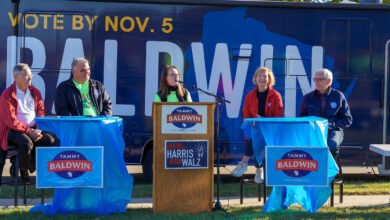Invests nearly $93 million in rural communities to lower energy costs and create jobs in Wisconsin – WisPolitics

23 projects will help build a more resilient and prosperous future for people living and operating businesses in rural Wisconsin.
Stevens Point, Wis., Oct. 9, 2024 – U.S. Department of Agriculture (USDA) Rural Development Wisconsin State Director Julie Lassa today announced that the Department is investing nearly $93 million through the Rural Energy for America (REAP) and the Powering Affordable Clean Energy (PACE) programs in rural communities to lower energy costs and create jobs in Wisconsin.
“Through the commitment of the Biden-Harris administration, USDA is investing in expanding renewable energy systems in rural communities across Wisconsin,” Lassa said. “This grant funding will invest directly in farmers, business owners, and cooperatives, helping lower energy costs and increase sustainability. With initiatives like these, together, we can continue our path forward to build a more resilient and prosperous future for people living and operating businesses in rural Wisconsin.”
Through the REAP program, $1.3 million in USDA Rural Development grants will bolster the efforts of 21 rural Wisconsin businesses to adapt or expand clean energy use. Among the REAP projects announced are several solar arrays, high efficiency LED lighting, a wind turbine, and a grain drying system. For example:
- In Outagamie County, Full Circle Community Farm will use its $40,850 REAP grant to install a wind turbine in Seymour. This project is expected to save the farm $8,000 in electrical costs per year and replace 40,000 kilowatt hours (80 percent of the farm’s energy use) per year, which is enough energy to power three homes.
- In Trempealeau County, Rotering Ridge Farms LLC will use its $55,374 REAP grant to help install a new grain drying system in Arcadia. This project is expected to save the farm $6,800 in electrical costs per year and replace 83,500 kilowatt hours (60 percent of the farm’s energy use for grain drying) per year, which is enough energy to power seven homes.
- In Oneida County, Cedar Falls Solar LLC will use its $696,396 REAP grant to install a solar electric array in Rhinelander. The project is expected to earn $140,000 per year by generating 1.7 million kilowatt hours per year, which is enough energy to power 159 homes.
Funding for the projects announced today in Wisconsin is part of $104 million that USDA has so far announced in REAP loans and grants that will support over 300 clean energy projects in 34 states.
Since January 2021, USDA has invested more than $2.3 billion through REAP in 7,923 renewable energy and energy efficiency improvements, including $42.7 million for more than 220 projects right here in Wisconsin.
Additionally, USDA is investing $91.5 million through the PACE program for solar photovoltaic generation at two sites in La Crosse County and 22 solar arrays in Dane County.
- In La Crosse County, Dairyland Power Cooperative plans to use a $15.6 million investment to finance the installation of 2 megawatts of solar photovoltaic generation at two sites, which will be connected to a 4 megawatt-hour battery energy storage system in western Wisconsin. This is enough electricity to power up to 1,000 homes. Dairyland Power Cooperative supports Wisconsin communities participating in the Biden-Harris Administration’s Rural Partners Network (RPN).
- In Dane County, Stag Moose Solar LLC plans to use a $75.9 million investment to finance 22 ground-mounted solar arrays that will produce 62.75 megawatts of renewable energy in Iowa, Wisconsin and Minnesota, which is enough electricity to power approximately 16,000 homes.
On September 25, State Director Lassa joined USDA Rural Utilities Service Administrator Andy Berke and White House Domestic Policy Advisor to the President, Neera Tanden at the Wisconsin Farmers Union’s Investing in Rural Wisconsin Roundtable in Chippewa Falls, where Tanden announced the PACE funding. RPN members highlighted their projects through PACE funding, including Dairyland Power Cooperative (DPC) Chief Executive Officer Brent Ridge. Ridge was one of six presenters who shared success stories made possible by receiving federal funding through several different programs.
REAP Background
REAP enables agricultural producers and rural small business owners to expand their use of wind, solar, geothermal and small hydropower energy and make energy efficiency improvements. These innovations help them increase their income, grow their businesses and address climate change while lowering energy costs for American families.
USDA continues to accept REAP applications and has set aside a portion of the program funds to support underutilized renewable energy technologies, like wind and geothermal power. For additional information, contact a local energy coordinator.
A complete list of recently announced REAP projects is available online.
PACE Background
PACE funding has helped achieve success across the United States. In May 2023, USDA made $1 billion available through PACE to fund new clean energy projects and energy storage in rural America. This program provides low interest loans with up to 60% loan forgiveness to renewable energy developers, rural electric cooperatives and other rural energy providers for renewable energy storage and projects that use wind, solar, hydropower, geothermal and biomass.
PACE is part of the Biden-Harris Administration’s Justice40 Initiative, which aims to ensure 40% of the overall benefits of certain federal climate, clean energy and other investment areas flow to disadvantaged communities that are marginalized by underinvestment and overburdened by pollution.
To date, USDA has selected 27 projects totaling more than $916 million to move forward in the PACE application process.
USDA expects to continue making PACE awards in the coming months.
USDA Rural Development provides loans and grants to expand economic opportunities, create jobs and improve the quality of life for millions of Americans in rural areas. USDA Rural Development supports infrastructure improvements; business development; housing; community facilities such as schools, public safety and health care; and high-speed internet access in rural, tribal and high-poverty areas. Visit the Rural Data Gateway to learn how and where these investments are impacting rural America. To subscribe to USDA Rural Development updates, visit the GovDelivery Subscriber Page.
USDA is an equal opportunity provider, employer, and lender.
Source link




